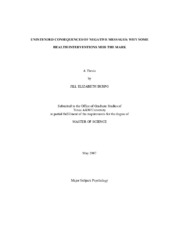| dc.description.abstract | The debate about how to frame health messages to maximize their effectiveness is ongoing. Research supports the use of both positive and negative frames under different conditions. This project was developed to further clarify the circumstances under which a negative frame may be harmful, or even backfire. In Study 1 it was proposed that past drinking behavior would moderate the relationship between message frame and behavioral intention to drink alcohol in the future such that people with a heavy drinking past would react to a negatively framed message by increasing their intention to consume alcohol. A total of 212 students participated in the study where they completed a questionnaire to provide information on some of the key variables, such as drinking history, and then were asked to read mock health materials with either a positive or negative frame. They concluded the study by responding to a final questionnaire where they provided feedback on the health materials and indicated their intentions to drink in the future. Results of this study supported the hypothesis. The goals of Study 2 were to replicate the findings of Study 1 and to test the hypothesis that self-esteem would be a second-order moderator of this effect such that people with a heavy drinking past and high self-esteem would be most likely to respond to a negatively framed message by increasing their intention to drink alcohol in the future. A total of 490 students participated in the study, which followed the same procedure as the first study. Results of Study 2 failed to replicate the findings from Study 1, and indicated that self-esteem did influence the relationship between past behavior, message frame and behavioral intention but not in the proposed direction. The marginally-significant effect found in Study 2 suggested that heavy drinkers with high self-esteem were actually more likely to decrease their intentions to drink alcohol after reading a negatively framed message. Because of the inconsistency in the results of the two studies presented, proposed directions for future research are discussed. | en |


